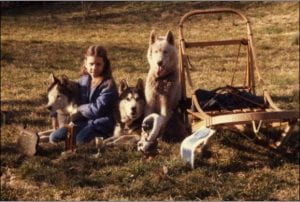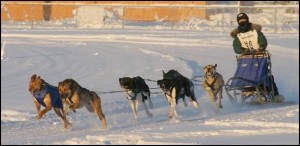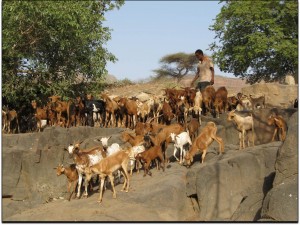
Department of Animal Science
Cornell University
507 Tower Rd.
201 Morrison Hall
Ithaca, NY 14853
Office phone: 607-255-2289
Email: hjh3@cornell.edu
A little about me and how I got here…
As a student, I always wanted to know how a person got the life and career they had. For me, it was a rather winding path to get where I am but each of the turns has had a huge impact on my outlook and what I do next.
My family is from York, PA, an area commonly referred to as Pennsylvania Dutch. I “blame” that heritage on my occasional odd speech and preference for some exceptionally awesome local foods including hogmal, Fitzkee’s candy, sugar cookies (not the common version), and Hershey’s chocolate.
 I grew up sprint racing Alaskan sled dogs in PA with my family. Each member of my family had a team of dogs and participated as active members of the Pennsylvania Sled Dog Club. On average, we had kennel of about 30 sled dogs and eventually moved to Adams, NY following the snow. I competitively raced throughout grade school and college, traveling through the northeast and midwest of the U.S. and Canada. I qualified and competed as a U.S. team member for the International Federation of Sled Dog Sports in Lake Placid, NY, 1995; sled dogs’ version of the Olympics.
I grew up sprint racing Alaskan sled dogs in PA with my family. Each member of my family had a team of dogs and participated as active members of the Pennsylvania Sled Dog Club. On average, we had kennel of about 30 sled dogs and eventually moved to Adams, NY following the snow. I competitively raced throughout grade school and college, traveling through the northeast and midwest of the U.S. and Canada. I qualified and competed as a U.S. team member for the International Federation of Sled Dog Sports in Lake Placid, NY, 1995; sled dogs’ version of the Olympics.
I attended Jefferson Community College in Watertown, NY, and transferred to Cornell University for my junior year, majoring in Animal Science. At the time, my focus was animal nutrition with a serious interest in veterinary medicine. Post-graduation saw me moving to Vermont, working as a veterinary technician, and continuing to race sled dogs. While I am very much a “dog” person, I also specialized in exotic animal medicine within the veterinary field and raptor and waterfowl rehabilitation in conjunction with the Vermont Raptor Center.
 Anyone who is serious about racing sled dogs, eventually ends up in Alaska (or wishes they were there!). I fell in love with Alaska on my first trip there during high school while racing. I still admit that my life goal was to move to Alaska, study wolves and whales, and race sled dogs…. In 2001, I moved to Salcha, AK with my kennel of sled dogs. I competed in another of the IFSS world championships in Fairbanks in 2001. I raced with the best of the best on some of the fastest sled dog race tracks in the world!
Anyone who is serious about racing sled dogs, eventually ends up in Alaska (or wishes they were there!). I fell in love with Alaska on my first trip there during high school while racing. I still admit that my life goal was to move to Alaska, study wolves and whales, and race sled dogs…. In 2001, I moved to Salcha, AK with my kennel of sled dogs. I competed in another of the IFSS world championships in Fairbanks in 2001. I raced with the best of the best on some of the fastest sled dog race tracks in the world!
I also took a new job at the University of Alaska, Fairbanks, as a genetics technician for Dr. George Happ. He studied the immune system diversity in Alaskan wildlife and Alaskan sled dogs. I conducted research in the lab and became the Alaska EPSCoR liaison, teaching rural high school teachers and students the basics of animal genetics and advising projects on local animals important to Alaskan culture. I flew into remote villages, slept in school hallways, camped with kids in the middle of “nowhere”, extracted DNA in the school woodworking room and viewed DNA results in the school’s darkroom (aka the janitor’s closet). In all, it was awesome! I learned about culture, foods, language, and life from the each of the students, villagers, and teachers that I worked with.
Eventually, I turned in my technician coat and opted for graduate school at the University of Alaska. My aim was animal genetics research and teaching, preferably at the college level. Plus, I couldn’t turn down the opportunity to study the genetics of athletic performance in Alaskan sled dogs! I admit it took me nearly 3 years as a genetics technician to warm up to the idea that I really did like genetics! For those of you in the field, my early career made me a firm believer that there really is a PCR god and it’s ok to rely on superstitious acts to ensure your lab experiment continues to work. Genetics became my tool to study my passion of sled dog racing… unfortunately, a student salary and time did not allow for racing. I retired from racing at the top of my class and kept a small group of dogs through their retirement.
My graduate work took an unexpected turn with an exceptional fellowship opportunity at the National Institutes of Health in Dr. Elaine Ostrander’s lab, a renowned dog geneticist. Hence, a culture-shock move from Alaska to Maryland/West Virginia. Six years later, I was a new mom of two and officially “Dr.” specializing in molecular genetics. I didn’t solve the secrets of Alaskan sled dog performance genetics but I made a significant dent in the knowledge of Alaskan sled dog ancestry and performance.
 I jumped from dog to livestock genetics when I took a post-doc with Dr. Curt Van Tassell at the USDA Bovine Functional Genomics Laboratory in Beltsville, MD. I wanted to learn more about genetic selection and improvement in animals. Dairy cattle are the leading species and Dr. Van Tassell and Dr. Tad Sonstegard are two of the leaders in the field. It was probably my willingness to jump into their new African goat improvement project, both in terms
I jumped from dog to livestock genetics when I took a post-doc with Dr. Curt Van Tassell at the USDA Bovine Functional Genomics Laboratory in Beltsville, MD. I wanted to learn more about genetic selection and improvement in animals. Dairy cattle are the leading species and Dr. Van Tassell and Dr. Tad Sonstegard are two of the leaders in the field. It was probably my willingness to jump into their new African goat improvement project, both in terms  of genetic analysis and field work (yes, that meant sampling goats across Africa!) that won them over in hiring a dog geneticist. Alaska was traded for a much hotter Africa but again I saw fantastic places and met incredible people. I gained a new appreciation for livestock genetics in comparison to wildlife and companion animals and saw a field dominated by the application of research in the real world. This was where I learned how to turn my research into something people and animals benefit from as opposed to a topic for my own interest.
of genetic analysis and field work (yes, that meant sampling goats across Africa!) that won them over in hiring a dog geneticist. Alaska was traded for a much hotter Africa but again I saw fantastic places and met incredible people. I gained a new appreciation for livestock genetics in comparison to wildlife and companion animals and saw a field dominated by the application of research in the real world. This was where I learned how to turn my research into something people and animals benefit from as opposed to a topic for my own interest.
Ithaca, NY remained a place I would happily return to and a faculty position at Cornell University in the Department of Animal Science brought me back here in 2013. This time my family accompanies me and I find myself teaching a course I took as an undergrad. My research in up and running and I have thoroughly enjoyed teaching. I have yet to master student names and recognize that the majority of my students are all taller than me but I have high hopes for making animal genetics a subject of interest in the coming years!
Media Releases
1. The Alaskan Sled Dog: A Genetic Breed Apart , National Institutes of Health, 2010
2. Genetic Study Uncovers Shared Breed Signature in Alaskan Sled Dogs, Genome Web Daily News, 2010
3. Canine Olympians, 23andMe Blog, 2012
4. Cornell New Faculty Profile, Cornell University, 2013
5. CALS Faculty Focus, Cornell University’s College of Agriculture and Life Sciences, Nov 2013
6. The Hunger Gains: Herding Diversity, periodiCALS, Cornell University’s College of Agriculture &Life Sciences Magazine, Vol 4, Issue 1, 2014, pg 16
7. Golden Helix SNP Variation Suite Webinar Presentation , This is a research presentation on cattle and goat genetics given for Golden Helix, July 22, 2014 “Population Structure and Genetic Improvement in Livestock”
8. Sled dogs lead the way in quest to slow aging, Cornell Chronicles, Cornell University’s magazine. November 2019